Possibilities of Evaluating the Effectiveness of Noise Barriers in Slovakia
Abstract
:1. Introduction
- Possibilities of evaluating of noise barriers’ effectiveness,
- Advantages and disadvantages of the individual methods of evaluating noise barriers’ acoustic characteristics;
- Measurement methods of acoustic performance and their realization on real noise barriers on selected sections of highways; and
- Discussion of the measured results from individual methods and their applicability.
2. Materials and Methods
2.1. Theory of Sound Energy Propagation Through a Noise Barrier
- Passes through the barrier to the recipient;
- Propagates around the upper edge of the noise barrier (diffraction);
- Is reflected back from the surface of the noise barrier;
- Is absorbed by the barrier (absorption); and
- Passes at the ends of the noise barrier to the receiver.
- Sound absorption—DLα;
- Sound insulation—DLSI,G; and
- Sound reflection—RIj.
2.1.1. Sound Absorption
- αSi—sound absorption coefficient in the i-th one-third octave band—is the ability of the body surface to absorb sound; the coefficient takes values from 0 to 1; 18 is a number of one-third octave bands; and
- Li—sound pressure level (A) of the normalized traffic noise spectrum in the i-th one-third octave band (dB).
- Reflective for DLα < 5 dB;
- Partly absorptive for 5 ≤ DLα ≤ 8 dB; and
- Absorptive for DLα > 8 dB.
2.1.2. Sound Insulation
- SIi—sound insulation index in the i-th one-third octave band; and
- Li—sound pressure level (A) of the normalized traffic noise spectrum in the i-th third-octave band (dB).
2.1.3. Sound Reflection
- m—the number of the lowest reliable one-third octave frequency band; according to EN 1793-5, the lowest reliable frequency is 300 Hz, which corresponds to m = 6; and
- Li—sound pressure level (A) of the normalized traffic noise spectrum in the i-th one-third octave band (dB).
2.2. Measurement by the Direct Method According to Standard ISO 10847
- DIL—insertion loss of the noise barrier;
- Lref, B—sound pressure level at the reference point without a barrier;
- Lr,B—sound pressure level at the reception point without a barrier;
- Lref,A—sound pressure level at the reference point with a barrier; and
- Lr,A—sound pressure level at the point of reception with a barrier.
2.3. Measurement by the Indirect Method According to Standard ISO 10847
- D′2IL—indirectly measured insertion loss of the noise barrier;
- ΔLA—theoretical value of the sound pressure expressed by the calculation with a barrier;
- ΔLB—theoretical value of the sound pressure expressed by the calculation without a barrier;
- Cr—correction factors for a free field in the hemisphere (Cr = 0 dB); and
- C′r—correction factors for reflective surfaces (C′r = 6 dB).
2.4. Measurement of Sound Insulation of a Barrier by the Adrienne Method
- Determination of the intrinsic characteristics of the sound insulation index of in situ or laboratory noise abatement equipment [29];
- Determination of the in situ intrinsic characteristics of the sound insulation index of noise reduction devices [29];
- Determination of sound reflection characteristics for in situ noise reduction in real conditions [27];
- Comparison of design characteristics with the values of the actual design after the completion of construction work [27].
- hik(t)—reference transmitted pulse response component of the free field in the k-th microphone position;
- htk(t)—transmitted pulse response component in the k-th microphone position;
- wik(t)—Adrienne temporal window for the reference transmitted pulse response component of the free field in the k-th microphone position;
- wtk(t)—Adrienne temporal window for the transmitted component in the k-th microphone position;
- F—symbol of the Fourier transform;
- j—index of the j-th one-third octave frequency band (between 100 Hz and 5 kHz);
- Δfj—the width of the j-th one-third octave frequency band; and
- N = 9—number of microphone positions.
- M—measurement grid of nine microphones (Figure 3a);
- S—noise source front panel—loudspeaker (Figure 3b);
- dS—horizontal distance (loudspeaker—noise source reference plane) at the height hS (m);
- hS—reference height—height of source position (m);
- tB—thickness of the barrier at the height hS (m);
- dM—horizontal distance of the central microphone (no 5) from the barrier at the height hS (m);
- hB—height of the barrier (m); and
- dT—horizontal distance between the loudspeaker and the central microphone at the height hS (dT = ds + tB + dM).
- DLSI,E–sound insulation index for acoustic element (panel) (dB); and
- DLSI,P–sound insulation index for pillar (dB).
3. Results
3.1. Determination of the Insertion Loss of a Barrier by the Indirect Method
- Lref,B—sound pressure level at the reference point without the barrier, microphone located at a height of 1.5 m above the level of the barrier, at an equivalent point with the place of installation of the barrier.
- Lr,B—sound pressure level at the reception point without the barrier, microphone located from the reference point Lref,B at a distance of 1.0 m behind the place of installation of the barrier and at a height of 1.5 m above the road surface.
- Lref,A—sound pressure level at the reference point with the barrier, microphone located at a height of 1.5 m above the barrier.
- Lr,A—sound pressure level at the reception point with the barrier, microphone located at a distance of 1.0 m behind the place of installation of the barrier and at a height of 1.5 m above the road surface.
3.2. Computer Simulation of the Nosie Barrier Effect
3.3. Measurement of Sound Insulation of the Noise Barrier 275-D4JS In Situ Using the Adrienne Method
- 0.8-m-high concrete plinth;
- Panel SGRABS500-V: 1.2–0.8 from the manufacturer Sugremin, C/Cronos 10, 4a planta, local 1 28,037 Madrid Spain—installed from 0.8 m to a height of 2.3 m of the total height of the noise barrier; and
- Polycarbonate panel installed from a height of 2.3 m of the total height of the noise barrier. The height of the installed polycarbonate panel varied along the length of the noise barrier. The noise barrier panels were placed on steel I-profiles spaced 3 m and 4 m apart. The overall dimensions of the test specimen were 4.8 m × 7.0 m (height × width). The total thickness of the panel was 0.1 m.
- DM = 0.25 m—horizontal distance (microphone grid, microphone no. 5—reference plane of the source) at a height hS;
- dS = 1.0 m—horizontal distance (loudspeaker—reference plane of the source) at a height hS;
- hB = 4.8 m—height of the barrier;
- hS = 2.4 m—reference height of the loudspeaker;
- tB = 0.1 m—thickness of the barrier at height hS.
- Analyser Apollo_Lt_2B—Analyzer for Sound and Vibration;
- Microphone M400_B;
- Amplifier ATLAS PA601 Power Amplifier—Single Channel, 60-Watt Power Amplifier with Global Power Supply; and
- AcoustiAdrienne Base Module.
4. Discussion
5. Conclusions
- Noise barriers’ effectiveness in Slovakia can be evaluated by three methods: the direct and indirect method in accordance with the standard ISO 10847, by simulation modelling according to the CNOSSOS method and in accordance with the standard EN 1793-6 (Adrienne method).
- By comparing the measurement methods of noise barriers’ acoustic characteristics, it can be stated that the method of ISO 10847 can be used in different measurement locations and only the reference point above the barrier is defined. The Adrienne method precisely defines the distances of the noise source and nine microphones from the noise barrier and its direct output is a value of the airborne sound insulation index obtained in situ for the whole structure. The simulation according to the CNOSSOS method is used for modeling the sound field. It enables comparison of the simulated values of the insertion loss of a barrier with the values measured according to the ISO 10847 standard and to assess whether the barrier satisfies the expectations.
- The measurement methods were used on real noise barriers on selected highway sections, thus real values of the insertion loss and airborne sound insulation index were obtained and gave a picture of their sound performance. The researched noise barriers were proven to be good quality.
- Construction materials that have given acoustic properties from the manufacturer (declared airborne sound insulation category D0 to D4) may lose these values over time due to material degradation. In addition, during the construction of noise barriers, defects can occur that contribute to reduced effectiveness. Measurement according to the EN 1793-6 Adrienne method is used to determine the quality of a noise barrier and its actual values of the airborne sound insulation index in situ. So, the Adrienne method can evaluate (degradation) the acoustic properties of a barrier in situ during a longer time period.
Author Contributions
Funding
Institutional Review Board Statement
Informed Consent Statement
Data Availability Statement
Acknowledgments
Conflicts of Interest
References
- Clausen, U.; Doll, C.; Franklin, F.J.; Franklin, G.V.; Heinrichmeyer, H.; Kochsiek, J.; Sieber, N. Reducing Railway Noise Pollution; European Parliament: Brussels, Belgium, 2012; pp. 10–55. [Google Scholar]
- European Environment Agency. Noise in Europe 2014. EEA report 10/2014; Publications Office of the European Union: Luxembourg, 2014. [Google Scholar]
- Environmental Noise Guidelines for the European Region. WHO Regional Office for Europe: Copenhagen, Denmark, 2018. Available online: https://www.euro.who.int/en/health-topics/environment-and-health/noise/environmental-noise-guidelines-for-the-european-region (accessed on 9 June 2021).
- Hurtley, C.H. (Ed.) Night Noise Guidelines for Europe. Geneva: WHO 2009. 184p. Available online: https://www.euro.who.int/__data/assets/pdf_file/0017/43316/E92845.pdf (accessed on 9 June 2021).
- Ižvolt, L.; Dobeš, P. Analysis of Measuring the Deformation Resistance of the Subgrade Surface of a Modernised Line Považská Teplá—Žilina. Civ. Environ. Eng. 2020, 16, 210–218. [Google Scholar] [CrossRef]
- NDSAS. Available online: https://www.ndsas.sk/stavby/dialnicna-siet (accessed on 2 June 2021).
- Lumnitzer, E.; Románová, M. Modeling of traffic noise and noise from stationary sources in the field of urban development (Modelovanie dopravného hluku a hluku z stacionárnych zdrojov v oblasti mestskej zástavby). Acta Mech. Slovaca 2005, 9, 225–228. (In Slovak) [Google Scholar]
- Ižvolt, L.; Hodás, S. Projektovanie, Stavba, Rekonštrukcia a Modernizácia Železničných Tratí a Staníc (Design, Construction, Reconstruction and Modernization of Railway Lines and Stations); EDIS: Žilina, Slovakia, 2020; p. 699. (In Slovak) [Google Scholar]
- Murphy, E.; King, E.A. Environmental Noise Pollution. Noise Mapping, Public Health, and Policy, 1st ed.; Elsevier: Amsterdam, The Netherlands, 2014; pp. 1–282. [Google Scholar]
- Ministry of Health of the Slovak Republic. Decree of the Ministry of Health No 549/2007 Coll. on Permissible Levels of Noise, Infrasound and Vibration and on the Objectification Requirements for Noise, Infrasound and Vibration in the Environment; Ministry of Health: Bratislava, Slovakia, 2007. (In Slovak)
- Margorínová, M.; Trojanová, M.; Decký, M.; Remišová, E. Noise costs from road transport. Civ. Environ. Eng. 2018, 14, 12–20. [Google Scholar] [CrossRef] [Green Version]
- Matonoková, L.; Krokker, A. Zásady Navrhovania Protihlukových Stien (Principles of Designing Noise Walls) (In Slovak). Available online: https://www.asb.sk/stavebnictvo/zaklady-a-hruba-stavba/priecky/zasady-navrhovania-protihlukovych-stien (accessed on 9 June 2021).
- Neubergová, K. Protihlukové Clony—Jejich Ztvárnění a Estetické Působení. (Noise Prevention Walls—Their Design and Aesthetic Effect) (in Czech). Available online: http://old.silnice-zeleznice.cz/clanek/protihlukove-clony-jejich-ztvarneni-a-esteticke-pusobeni/ (accessed on 9 June 2021).
- Hübner, P.; Oertli, J. Noise Reduction in European Railway Infrastructure. Status Report 2007; SB Imprimeurs: Paris, France, 2007; p. 40. [Google Scholar]
- Communication from the Commission to the European Parliament, the Council, the European Economic and Social Committee and the Committee of the Regions. Available online: https://eur-lex.europa.eu/legal-content/EN/TXT/DOC/?uri=CELEX:52013DC0913&from=SK (accessed on 7 June 2021).
- Ďurčanská, D. Posudzovanie Vplyvov ciest a Diaľníc na Životné Prostredie. Hluk a Imisie z Cestnej Dopravy (Environmental Impact Assessment of Roads and Motorways. Noise and Immissions from Road Transport); EDIS: Žilina, Slovak, 2002. (In Slovak) [Google Scholar]
- Lazarová, P.; Beck, Z. Methodology ways of reducing traffic noise. In Proceedings of the 13rd Management of Environment International Conference, Bratislava, Slovakia, 18–19 April 2013; pp. 133–139. [Google Scholar]
- Anping Zenyo Wire Mesh Products Co. Available online: http://chinawire-mesh.com/Product/Sound%20Barriers/verticaltypeofnoisebarrier.html (accessed on 7 June 2021).
- Quietstone UK Ltd. Available online: http://chinawire-mesh.com/Product/Sound%20Barriers/verticaltypeofnoisebarrier.html (accessed on 7 June 2021).
- Knauf Insulation OEM. Available online: https://www.oem.knaufinsulation.com/solutions/road-sound-barriers (accessed on 7 June 2021).
- Hatko Sound Barriers & Noise Wall Panels. Available online: https://www.hatkosoundbarrier.com/how-to-design-effective-noise-barriers/ (accessed on 7 June 2021).
- OBEX Systems. Available online: https://obexsystems.com/barriers/noise-barriers/ (accessed on 7 June 2021).
- Salaiová, B.; Mandula, J.; Kovaľaková, M. Vybrané Kapitoly z Cestných a Železničných Stavieb. Hluk z Dopravy (Selected Chapters from Road and Railway Constructions. Traffic Noise); TU: Košice, Slovak, 2001. (In Slovak) [Google Scholar]
- Úrad pre normalizáciu, metrológiu a skúšobníctvo Slovenskej republiky. EN 1793-1. Road Traffic Noise Reducing Devices. Test Method for Determining the Acoustic Performance. Part 1: Intrinsic Characteristics of Sound Absorption; Úrad pre normalizáciu, metrológiu a skúšobníctvo Slovenskej republiky: Bratislava, Slovakia, 2017. [Google Scholar]
- Puškáš, J.; Schwarz, J.; Hofman, R.; Tomašovič, P.; Zajac, J. Znižovanie Hluku v Pozemných Stavbách (Noise Reduction in Buildings); Alfa: Bratislava, Czechoslovakia, 1988. (In Slovak) [Google Scholar]
- Úrad pre normalizáciu, metrológiu a skúšobníctvo Slovenskej republiky. EN 1793-2 Road Traffic Noise Reducing Devices. Test Method for Determining the Acoustic Performance. Part 2: Intrinsic Characteristics of Airborne Sound Insulation; Úrad pre normalizáciu, metrológiu a skúšobníctvo Slovenskej republiky: Bratislava, Slovakia, 2018. [Google Scholar]
- Úrad pre normalizáciu, metrológiu a skúšobníctvo Slovenskej republiky. EN 1793-5: Road Traffic Noise Reducing Devices—Test Method for Determining the Acoustic Performance—Part 5: Intrinsic Characteristics—In Situ Values of Sound Reflection under Direct Sound Field Conditions; Úrad pre normalizáciu, metrológiu a skúšobníctvo Slovenskej republiky: Bratislava, Slovakia, 2016. [Google Scholar]
- The International Organization for Standardization. ISO 10847 Acoustics—In-Situ Determination of Insertion Loss of Outdoor Noise Barriers of All Types; The International Organization for Standardization: Geneva, Switzerland, 1997. [Google Scholar]
- Úrad pre normalizáciu, metrológiu a skúšobníctvo Slovenskej republiky. EN 1793-6: Road Traffic Noise Reducing Devices—Test Method for Determining the Acoustic Performance—Part 6: Intrinsic Characteristics—In Situ Values of Airborne Sound Insulation under Direct Sound Field Conditions; Úrad pre normalizáciu, metrológiu a skúšobníctvo Slovenskej republiky: Bratislava, Slovakia, 2018. [Google Scholar]
- Solution AcoustiAdrienne AED811. Available online: https://www.alliantech.com/img/cms/PDF%20blog/Solution%20AcoustiAdrienne%20Norme%201793-6.pdf (accessed on 14 June 2021).
- Commission Directive (EU) 2015/996 of 19 May 2015 Establishing Common Noise Assessment Methods According to Directive 2002/49/EC of the European Parliament and of the Council. Available online: https://eur-lex.europa.eu/legal-content/EN/TXT/PDF/?uri=CELEX:32015L0996&from=PT (accessed on 14 June 2021).
- Kephalopoulos, S.; Paviotti, M.; Anfosso, L.F. Common Noise Assessment Methods in Europe (CNOSSOS-EU); Publications Office of the European Union: Luxembourg, 2012; 180p. [Google Scholar]
- Pultznerová, A.; Panulinová, E.; Kuchárová, D.; Argalášová, Ľ. Railway noise annoyance on the railway track in Northwest Slovakia. Noise Health 2018, 20/94, 90–100. [Google Scholar]
- Van Renterghem, T.; Aletta, F.; Botteldooren, D. Changes in the Soundscape of the Public Space Close to a Highway by a Noise Control Intervention. Sustainability 2021, 13, 5284. [Google Scholar] [CrossRef]
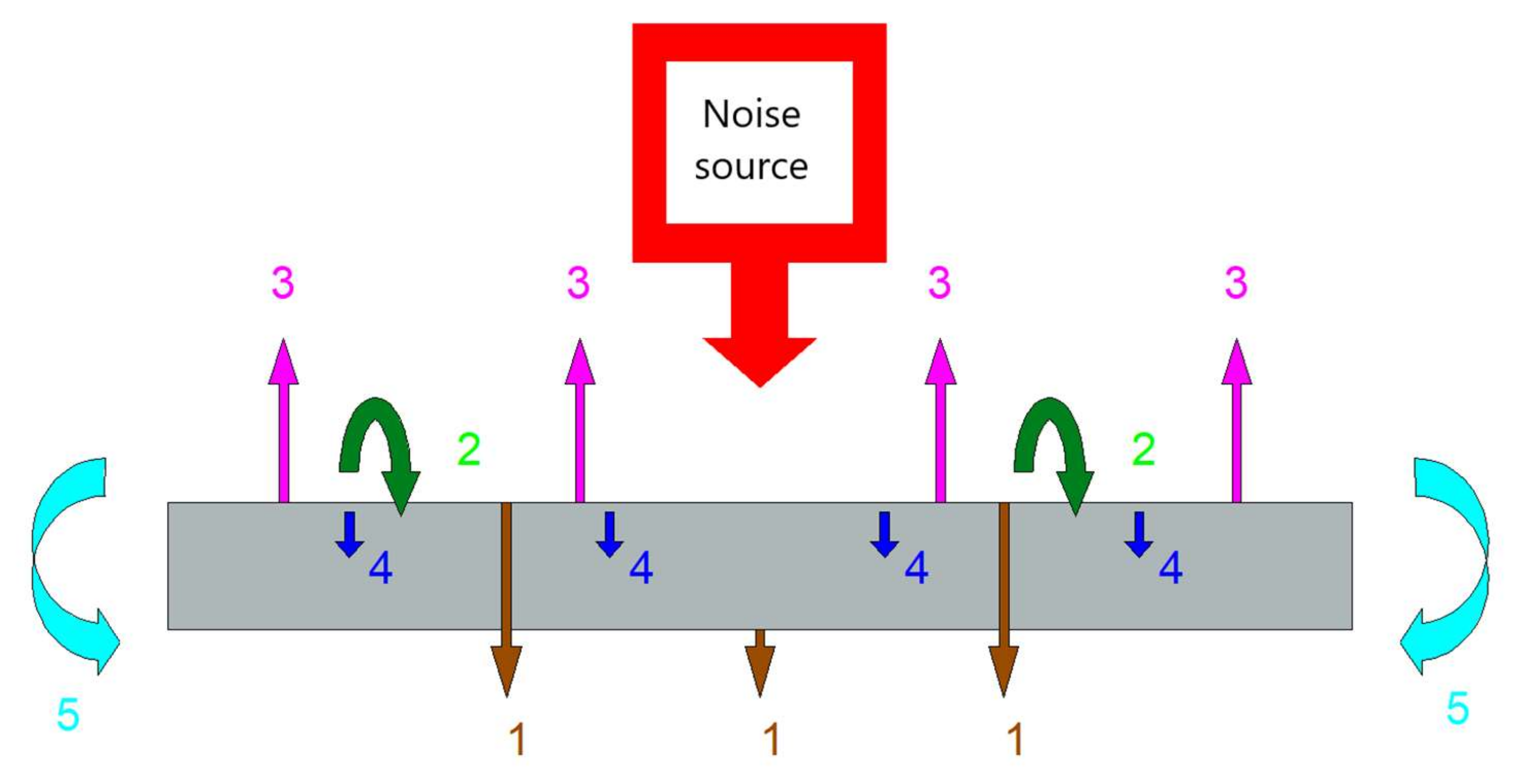
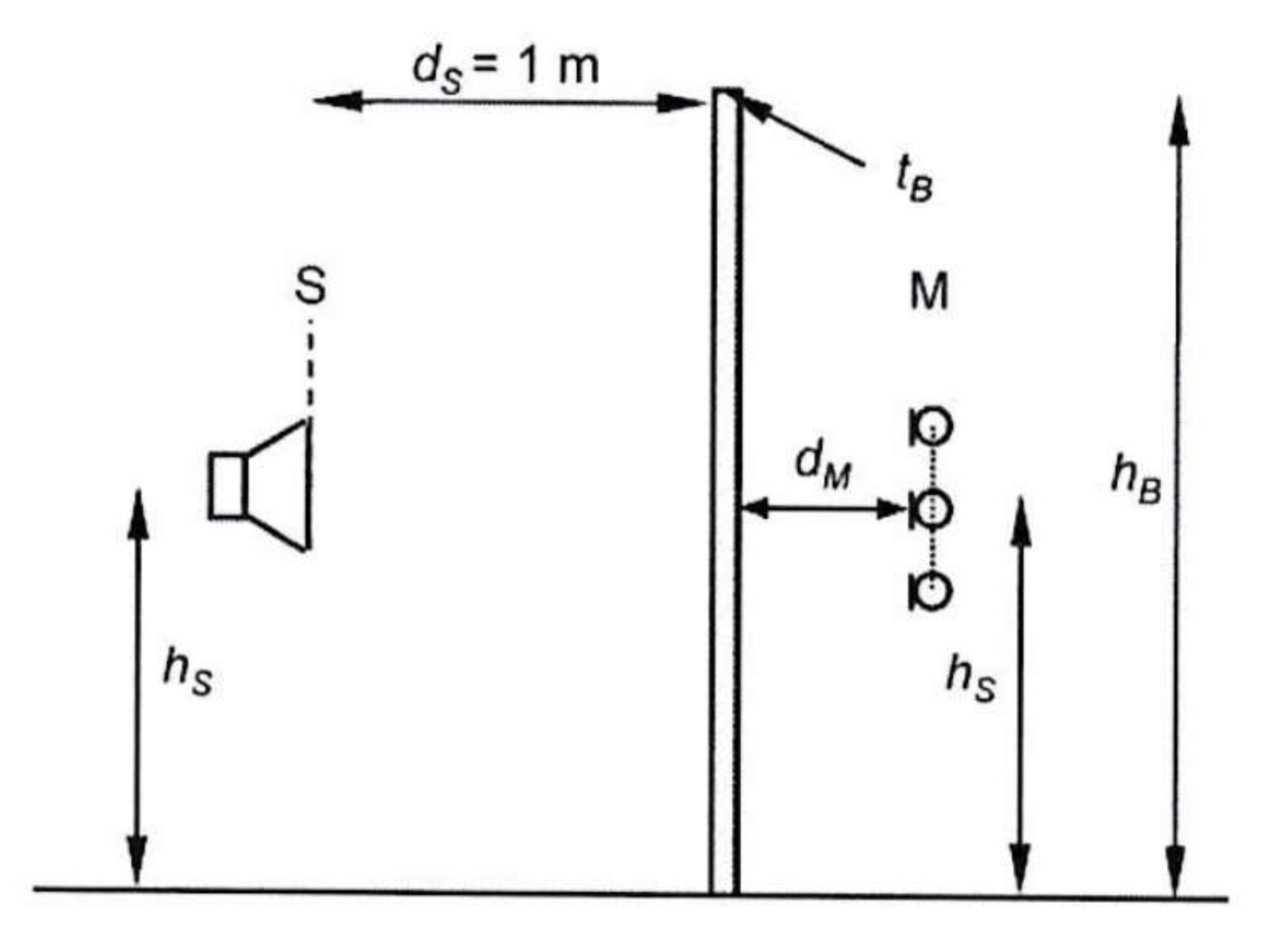
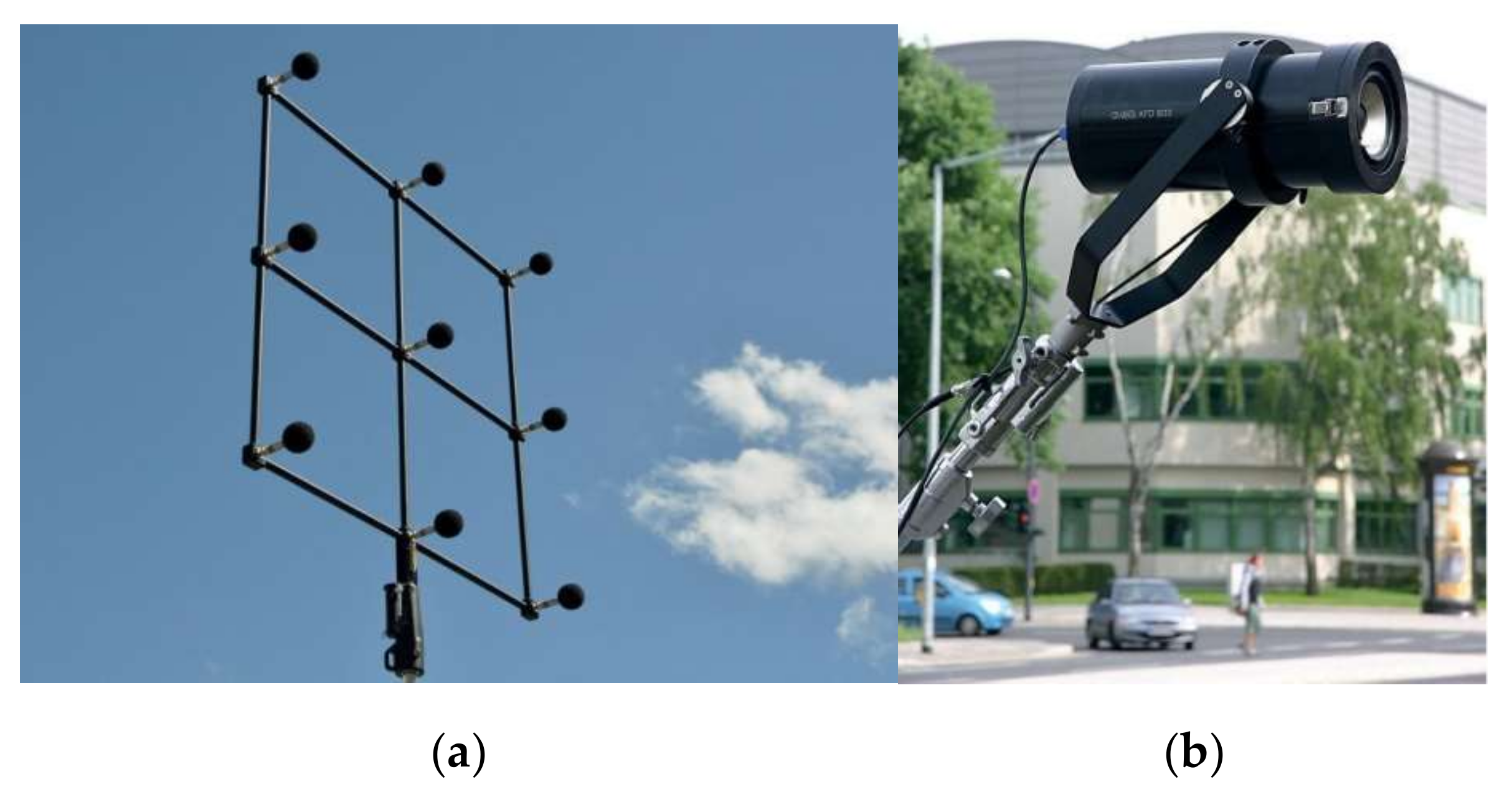
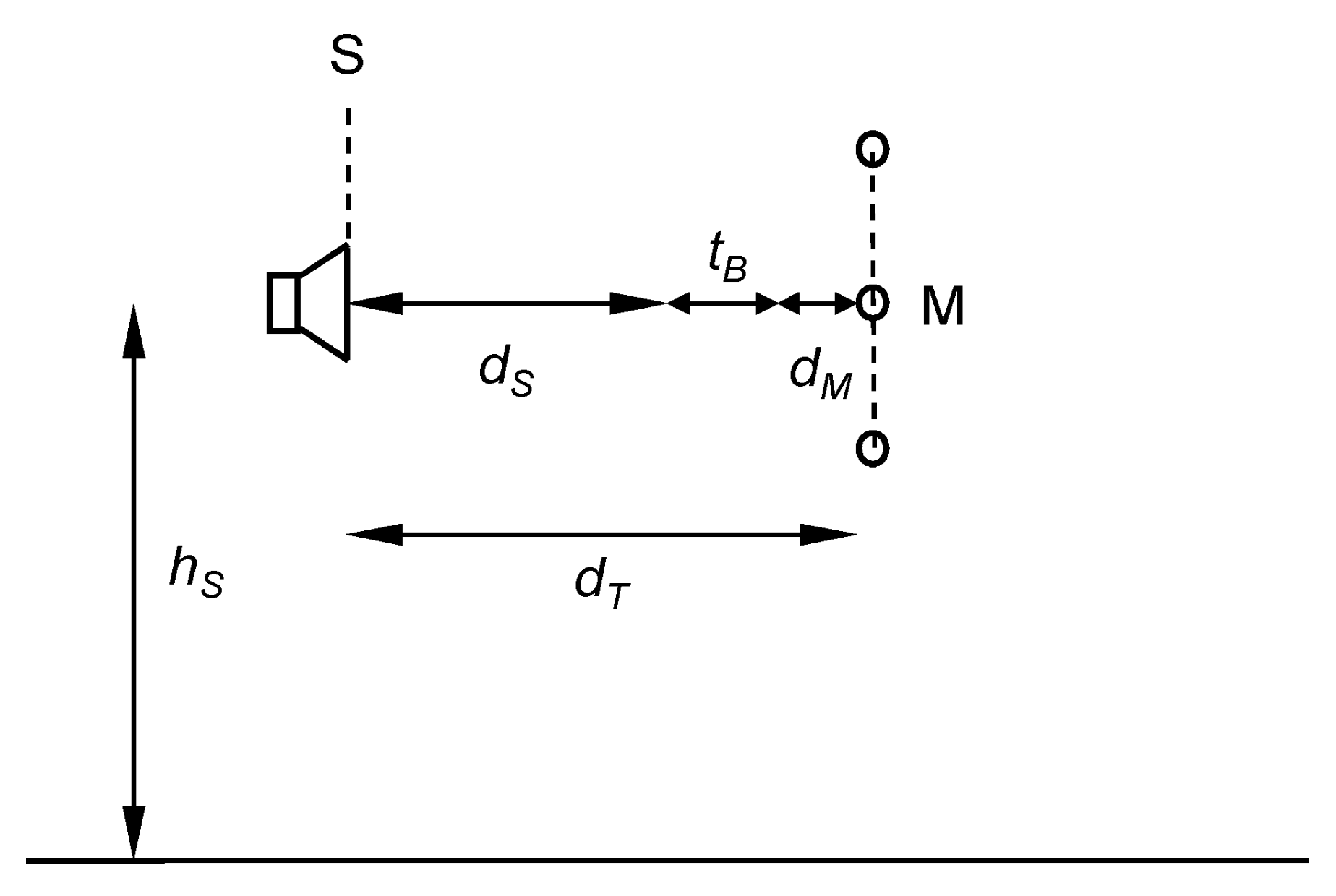

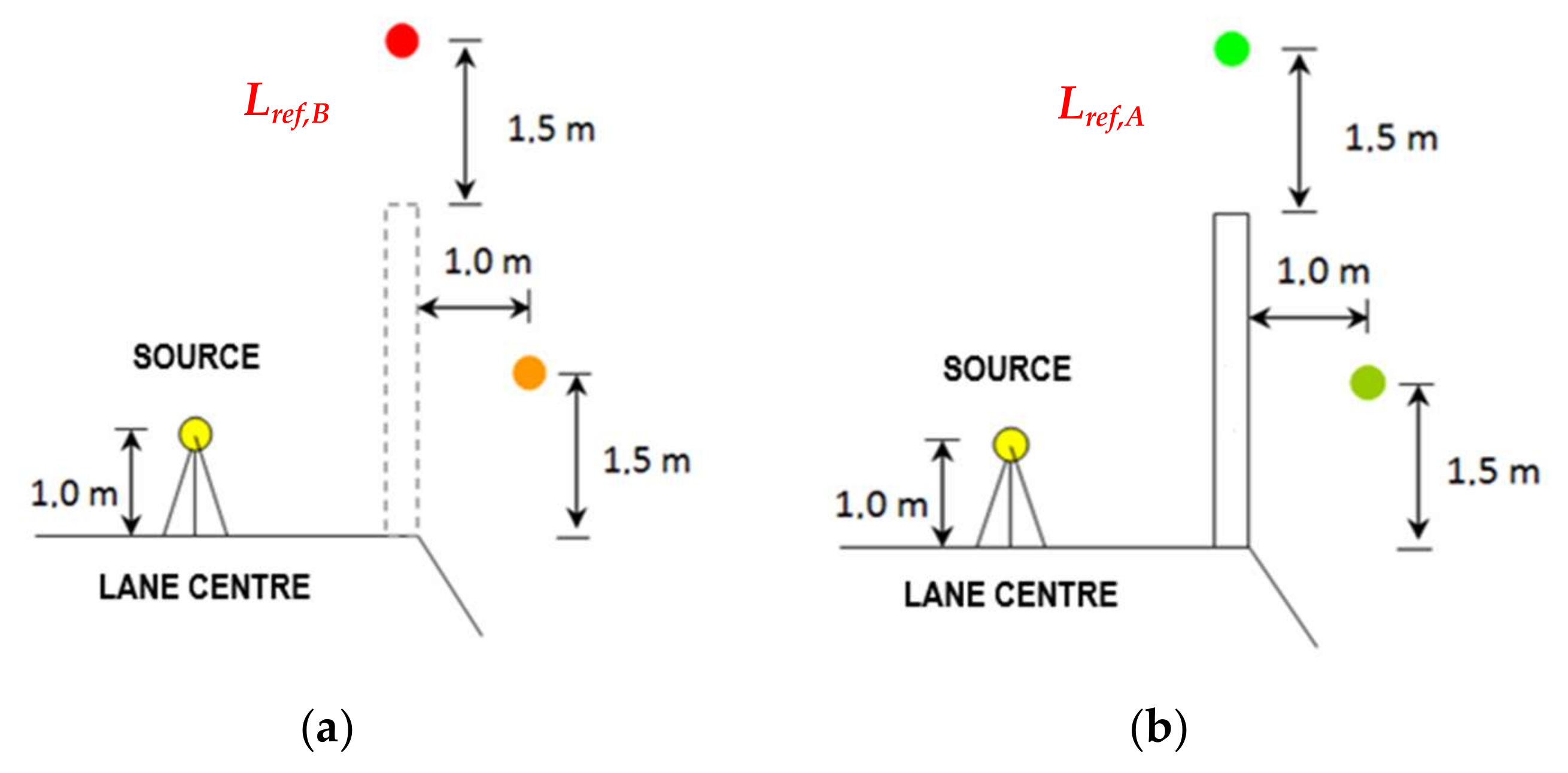
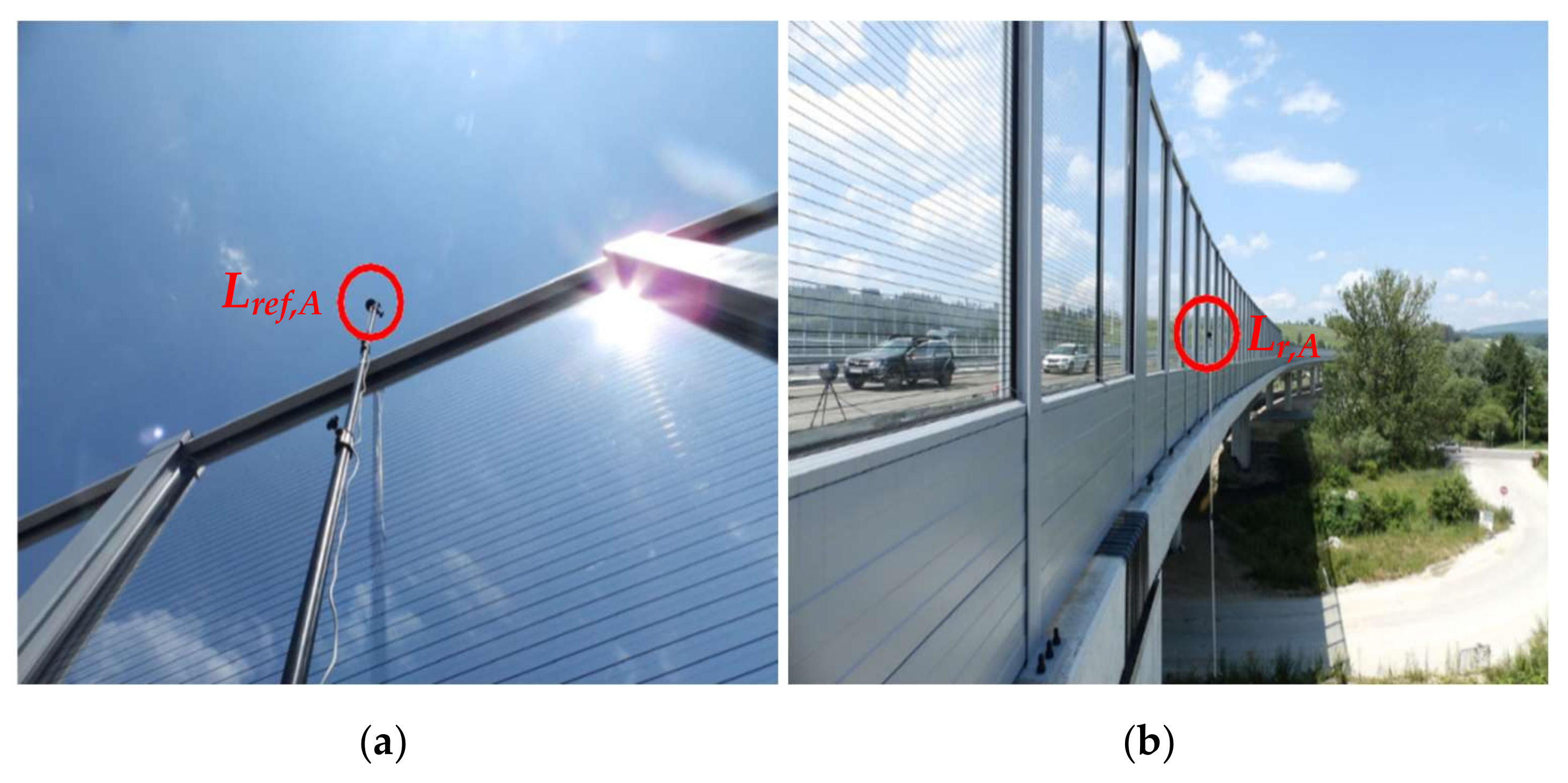
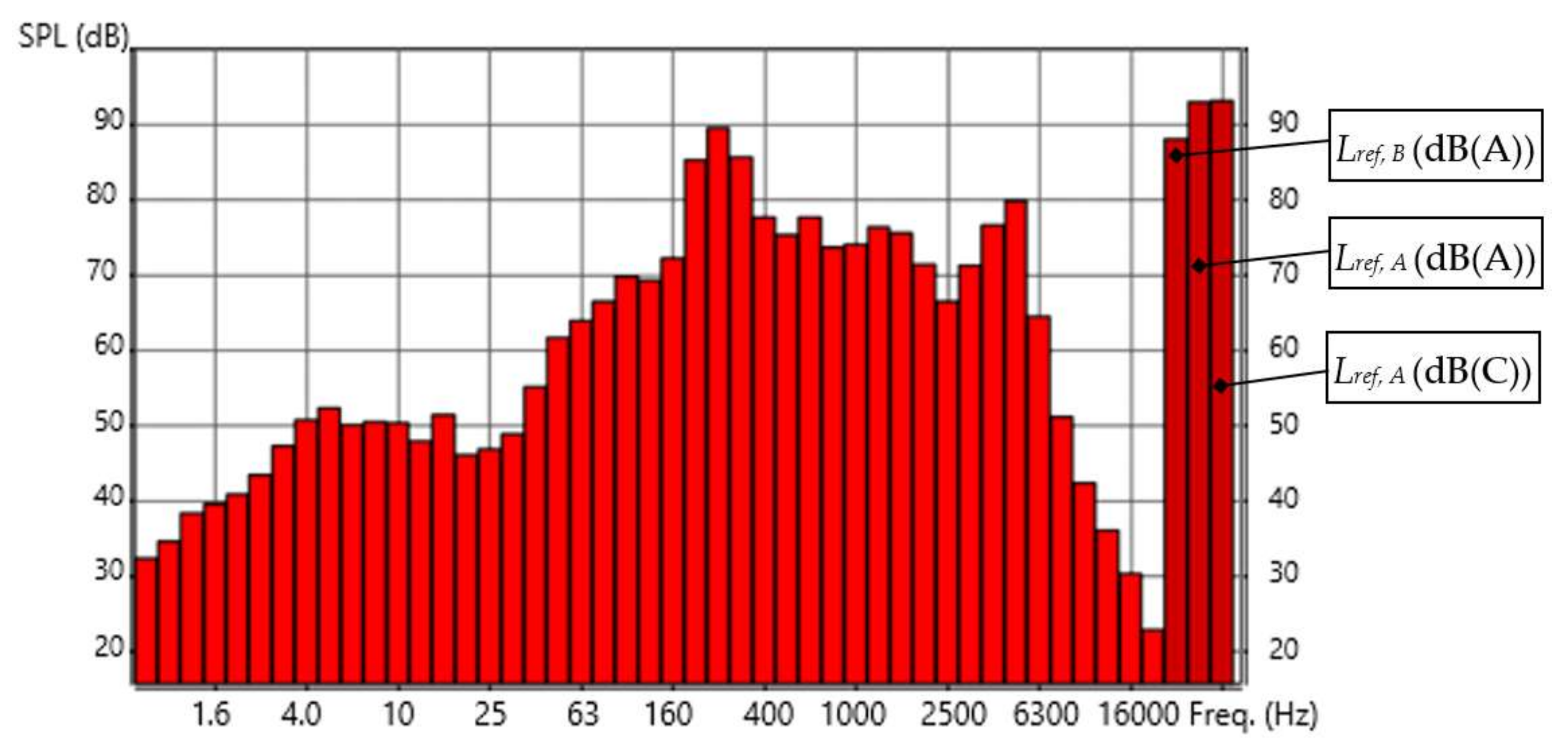

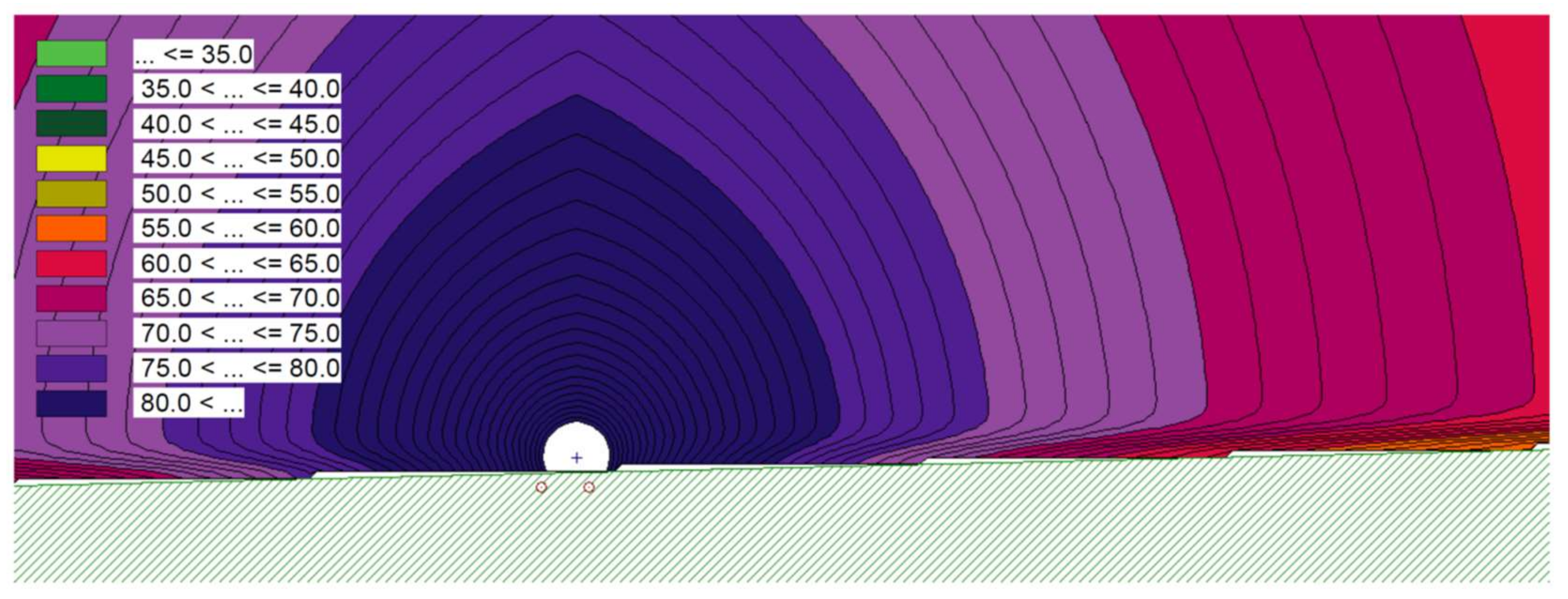
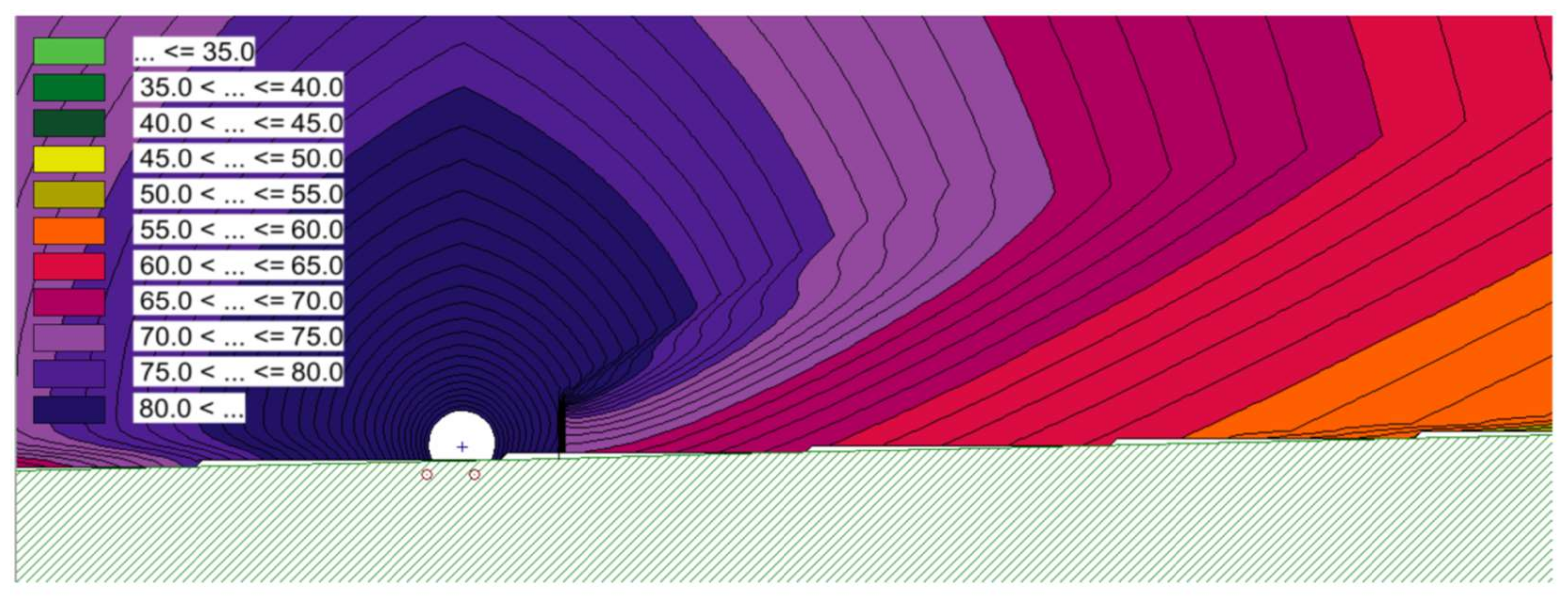
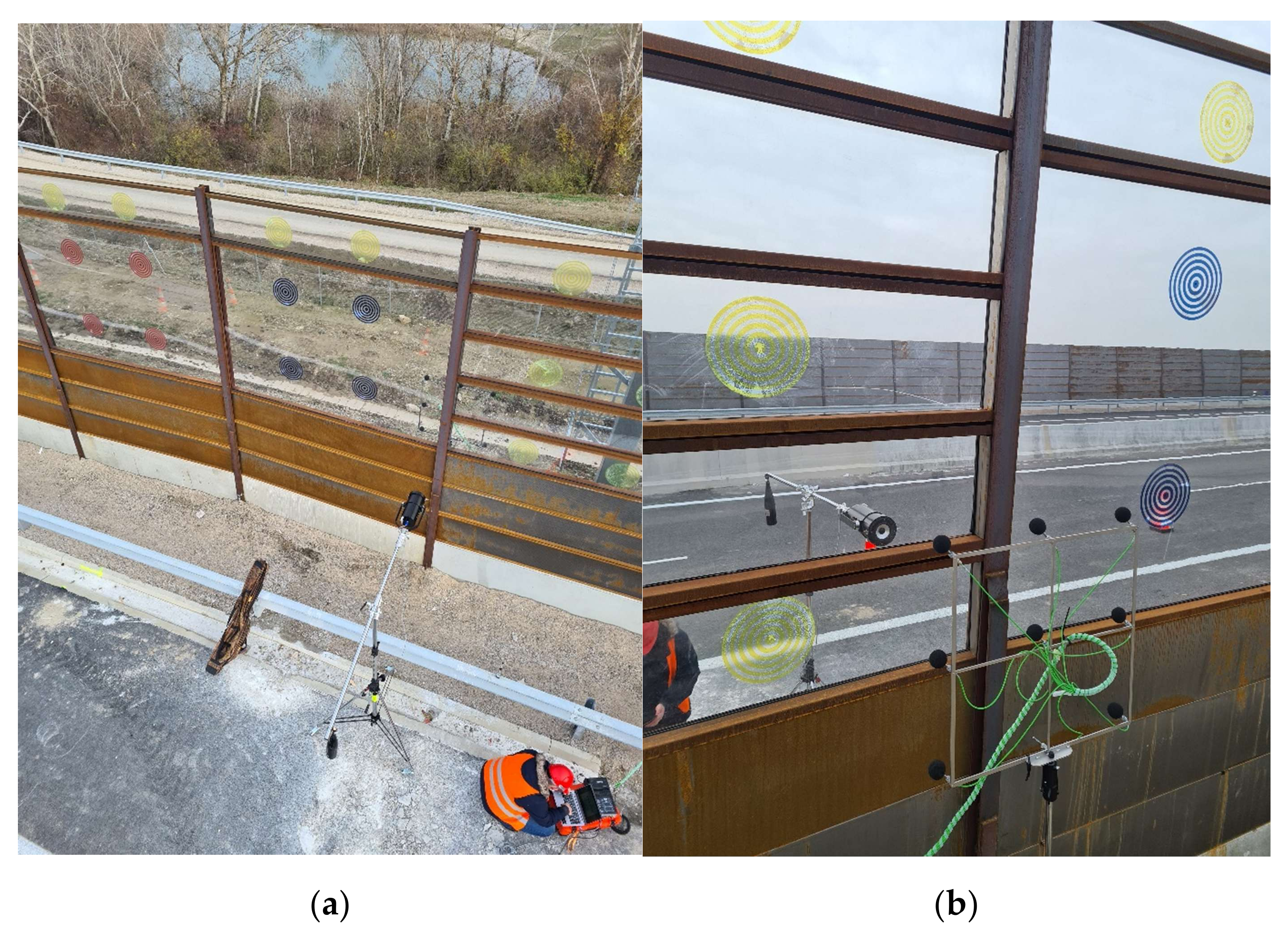
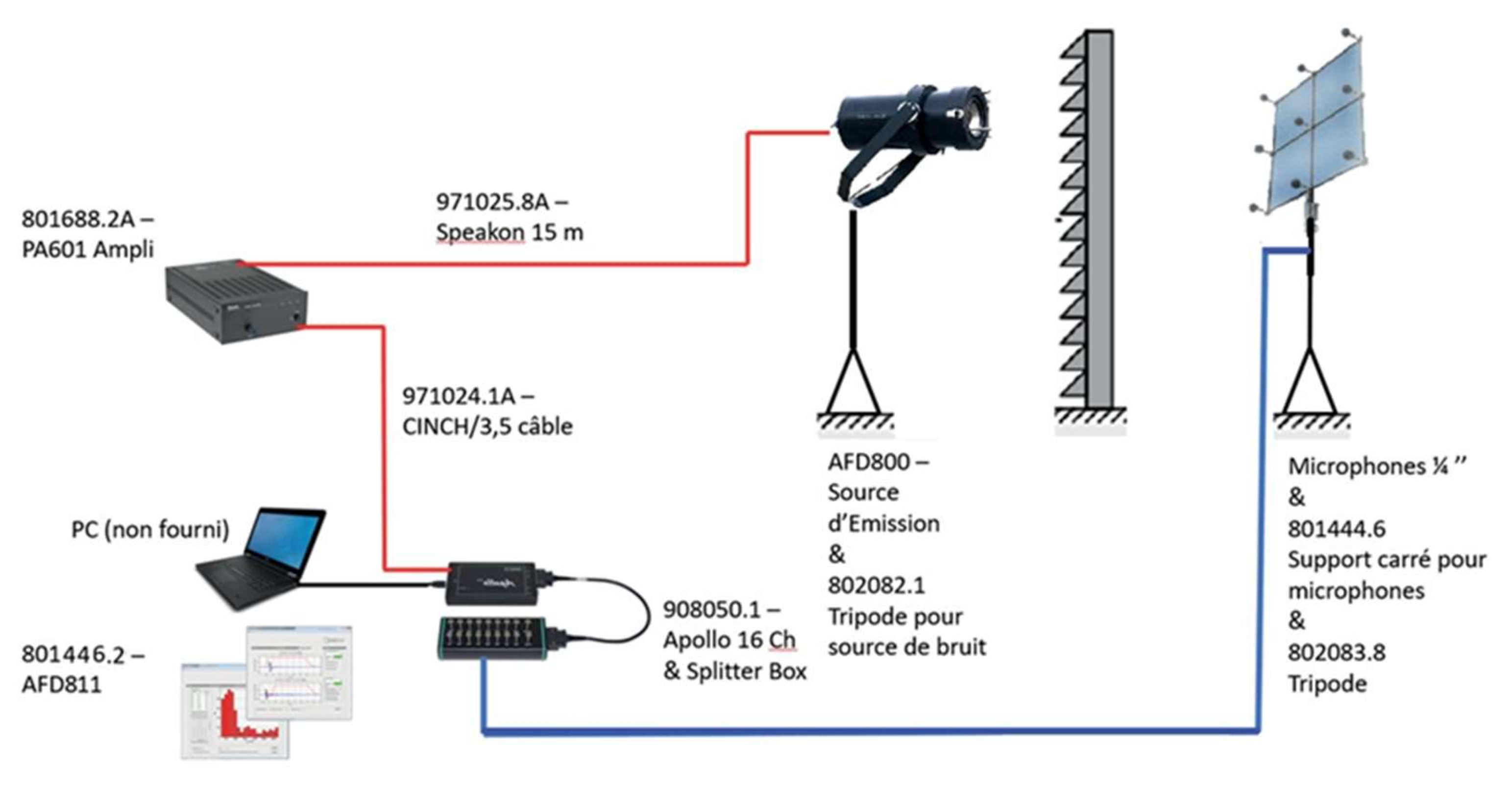
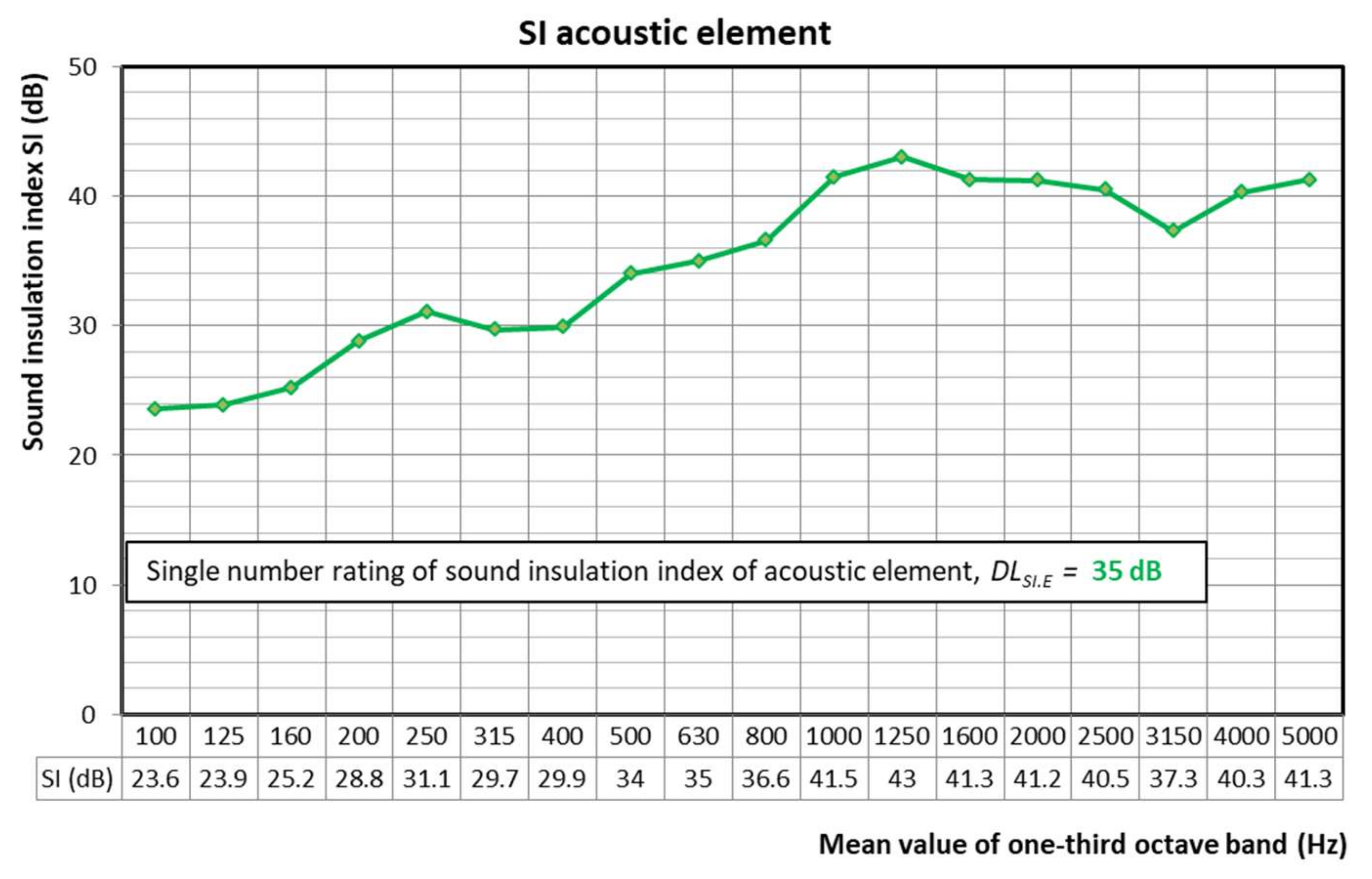
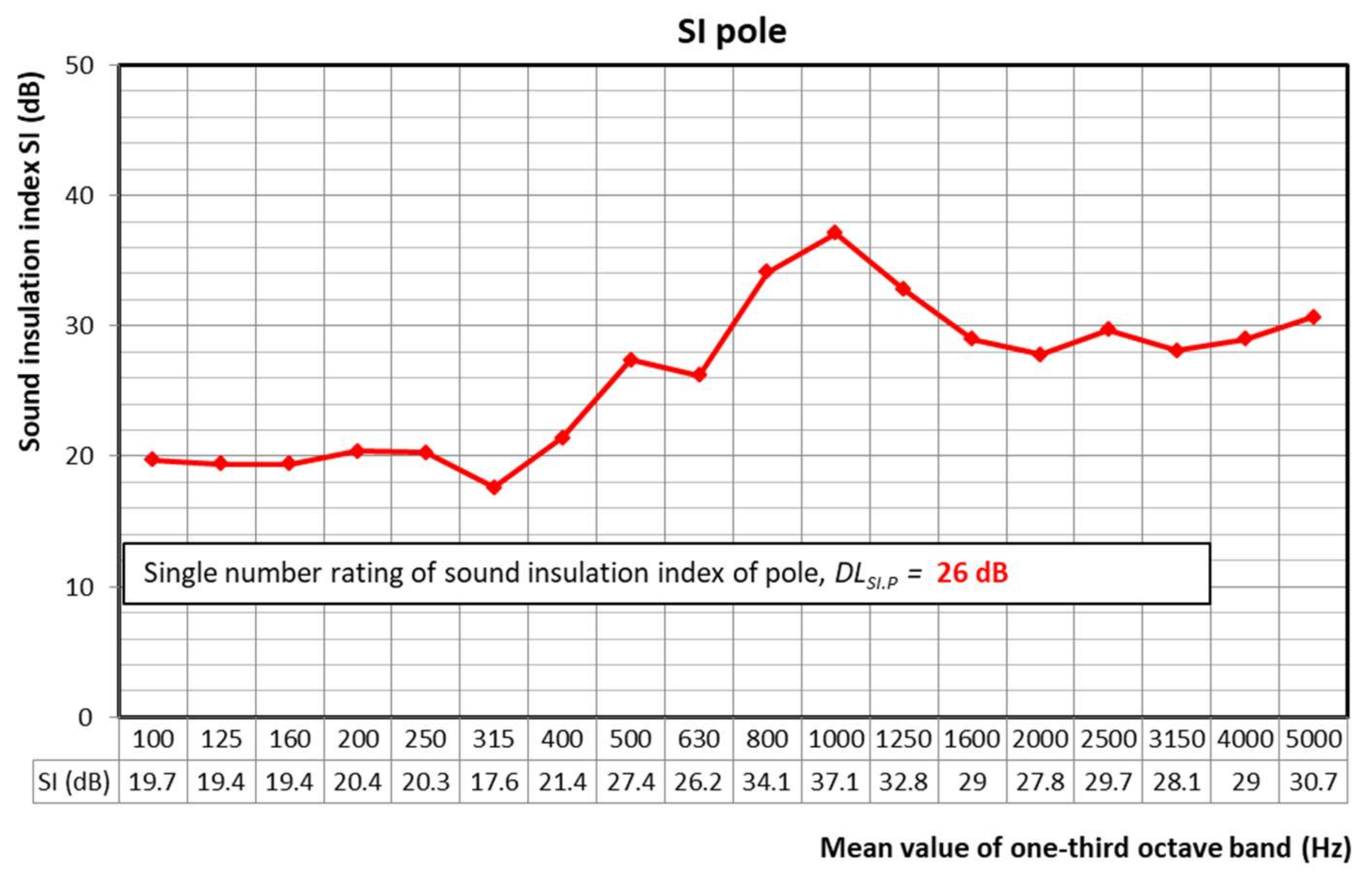
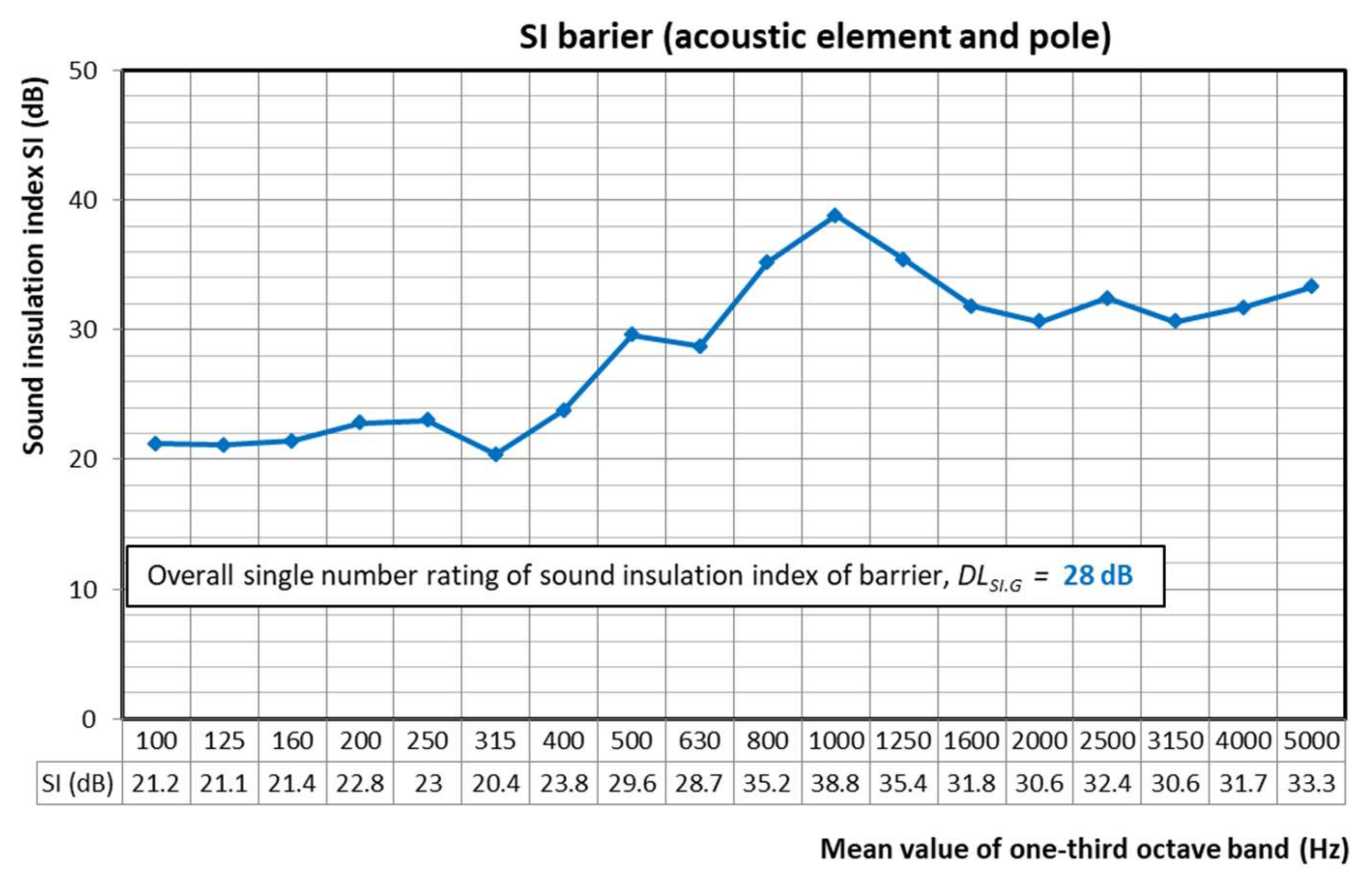
| Category | DLα (dB) |
|---|---|
| A0 | Not specified |
| A1 | <4 |
| A2 | 4–7 |
| A3 | 8–11 |
| A4 | >11 |
| Category | DLα (dB) |
|---|---|
| D0 | Not specified |
| D1 | <14 |
| D2 | 16–27 |
| D3 | 28–36 |
| D4 | >36 |
| Date | Air Temperature (°C) | Wind (m s−1) | Wind Direction | Air Humidity (%) | Cloud Cover Class |
|---|---|---|---|---|---|
| 25 June 2019 | 29–31 | 0–1 | Variable-W | 65–70 | 3 |
| Lr,B (dB(A)) | Lref,B (dB(A)) | Lr,A (dB(A)) | Lref,A (dB(A)) | ΔLA (dB(A)) | ΔLB (dB(A)) | D′IL (dB(A)) |
|---|---|---|---|---|---|---|
| 67.2 | 88.2 | 59.3 | 93.4 | 34.1 | 15.0 | 19.1 |
Publisher’s Note: MDPI stays neutral with regard to jurisdictional claims in published maps and institutional affiliations. |
© 2021 by the authors. Licensee MDPI, Basel, Switzerland. This article is an open access article distributed under the terms and conditions of the Creative Commons Attribution (CC BY) license (https://creativecommons.org/licenses/by/4.0/).
Share and Cite
Pultznerová, A.; Šimo, J.; Grenčík, J. Possibilities of Evaluating the Effectiveness of Noise Barriers in Slovakia. Appl. Sci. 2021, 11, 10206. https://doi.org/10.3390/app112110206
Pultznerová A, Šimo J, Grenčík J. Possibilities of Evaluating the Effectiveness of Noise Barriers in Slovakia. Applied Sciences. 2021; 11(21):10206. https://doi.org/10.3390/app112110206
Chicago/Turabian StylePultznerová, Alžbeta, Ján Šimo, and Juraj Grenčík. 2021. "Possibilities of Evaluating the Effectiveness of Noise Barriers in Slovakia" Applied Sciences 11, no. 21: 10206. https://doi.org/10.3390/app112110206
APA StylePultznerová, A., Šimo, J., & Grenčík, J. (2021). Possibilities of Evaluating the Effectiveness of Noise Barriers in Slovakia. Applied Sciences, 11(21), 10206. https://doi.org/10.3390/app112110206






